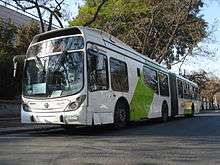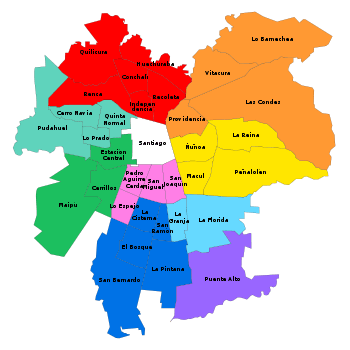Transantiago
|
| |
|
| |
| Founded | 2007 |
|---|---|
| Headquarters | 9 Nueva York Street, 10th Floor |
| Locale | Santiago, Chile |
| Service area | Greater Santiago |
| Service type | Public transport |
| Routes |
391 bus lines 5 metro lines 1 Metrotrén line |
| Stations |
11,165 bus stops 108 metro stations 10 Metrotrén stations |
| Fleet |
6,581 buses 190 metro trains 40 interurban trains |
| Daily ridership |
Bus: 3,300,000 approx. Metro: 2,700,000 approx. Metrotrén: 1,200,000 approx. |
| Operator |
|
| Website | Transantiago |
Transantiago is a public transport system that serves Santiago, the capital of Chile. It is considered the most ambitious transport reform undertaken by a developing country according to the World Resources Institute.[1]
The system, largely influenced by Bogotá, Colombia's TransMilenio and Curitiba, Brazil's RIT, was introduced on February 10, 2007. It standardized bus routes and eliminated redundancy of same; redundancies were commonplace in the old system, which was run by thousands of independent bus operators. The system combines local (feeder) bus lines, main bus lines and the Metro (subway) network. It includes an integrated fare system, which allows passengers to make bus-to-bus or bus-to-metro transfers for the price of one ticket, using a single contactless smart card.
Transantiago's implementation was problematic, as the decreased bus fleet and the newer routes have proved insufficient to properly serve a population inadequately informed of pending changes. The major complaints are the lack of buses and their inconsistent frequencies, missing or poor infrastructure (such as segregated corridors, prepaid areas and bus stops), the network's coverage, and the number of transfers needed for longer trips. As a result, users have overcrowded the Metro, which is generally held to be fast and dependable.
Details
Transantiago's first stage of implementation began on October 22, 2005, when a group of ten new companies took control of the capital's bus system, immediately introducing 1,181 new, modern low-floor buses (approximately half of them being articulated) made by Volvo in Brazil, replacing 461 yellow-colored buses from the old system. The new buses will temporarily run alongside the over 7,000 existing older buses that will be gradually removed from the system until 2010. In October 2006, a users' information system was introduced.
Transantiago became fully operational on February 10, 2007, with the introduction of a new route system dividing bus lines into two complementary groups: main and local lines. In addition, a new fare structure was implemented, allowing transfers at small or zero fares between buses and metro, when using the new contactless smartcard. 1,776 new buses will operate at this stage. The older yellow-colored (now painted over) buses will only operate through the secondary local lines in conjunction with new but simpler buses. It is expected that by 2010, the older buses will be completely replaced by over 4,600 new vehicles.
Objectives
- Encouraging the use of public transport
- Enhancing the quality of public transport, eliminating the on-the-street competition and replacing the existing bus fleet
- Palliating the city's high air and sound pollution levels by reducing the number of buses from over 7,000 to about 4,600, and by reducing the emission levels of the buses
- Reducing travel times
New lines structure
Bus services were divided into two subsystems. The first subsystem corresponds to the main bus lines, which complementing the metro network allow long trips between different zones of the city. The second subsystem corresponds to the local (or feeder) bus lines, which allow short trips and feed the metro and main bus lines. Local services are organized in ten units, each corresponding to one or more municipalities of Santiago.
In June 2012, the scheme of local and trunk services was disbanded. The requirement to have each business unit with different companies was eliminated and the relationship between these tours are encouraged, in order to provide better service to passengers by reducing transfers. From that moment seven operating units, each assigned to a concessionaire which included both trunk and local services were generated. The buses are painted, according to Business Unit won each company, which is identified by a specific color. In this way, the color of the buses does not represent the zone covering the system as stipulated in the beginning and remained until June 2012.
| U1 | Alsacia | Servicios 100 |
| U2 | Subus Chile | Servicios 200 y G |
| U3 | Buses Vule | Servicios 300, E, H e I |
| U4 | Express de Santiago Uno | Servicios 400 y D |
| U5 | Metbus | Servicios 500 y J |
| U6 | Veolia Redbus Urbano | Servicios B y C |
| U7 | S.T.P. Santiago | Servicios F |
The details of both the main bus lines and the local bus lines can be seen in the official .
New fare structure
An integrated fares scheme was introduced for buses and metro, allowing to transfer for free or paying a small transfer charge. During the first six months of operation, up to three transfers are completely free. The definitive fare scheme considers two basic fares (local and main fares), in addition to the transfer fares.
The local fare will allow local trips inside a local area, also allowing free transfers between local services in that area. The main fare will be a little higher and will allow trips both in the main bus lines and metro, including free transfers between them. Finally, a transfer fare will have to be paid when transferring between a main bus service (or metro) and a local service. This transfer fare will be much smaller than the basic fares. As before, students will be allowed to pay reduced fares, at 35% of the normal ones.
Fares will be adjusted periodically, according to the changes in the main input prices (fuel, etc.) of the operators. The way in which the fare adjustments is calculated has been established in the operation contracts. Therefore, neither operators nor the authorities are able to change the fares at will.
Payment and financial administration

The main payment system of Transantiago is a Contactless smart card called Tarjeta Bip! similar to the Multivia card, which was previously operated by the metro. This card is used both in buses and metro as a prepaid card. The access to the reduced or free transfer fares is only possible when using this card, as the electronic system associated to the card automatically recognizes if users are starting their trip or just making a transfer. In this way, the system can determine whether the basic fare is to be charged or if a transfer or free fare applies. Passengers who do not have the card may pay in cash (only in feeder buses), but at a higher fare and without possibility of reduced transfers.
The operation of the payment system was tendered to a private company. Its main tasks are the distribution and charging of the card, the administration of the revenues and the payment to the operators, according to the rules established in the contracts.
User information
Another component of the system is the information manager and users' information provider, which was tendered and awarded to the private company Tata Consultancy Services Chile in 2007. Its main tasks are: provide information for the users both before and after the implementation of the system, provide information about the localization of the buses to the operators and coordinate emergencies with the relevant bodies.
Vehicles

Until 2010 there will be both new Transantiago-standard and old buses in operation. In comparison to the old buses of Santiago, at least half the new ones have a low floor, and all have a blocking system that does not allow the bus to move before all doors are closed (Although the later doesn't always work, since there have been many cases of people almost falling down the bus). Since 2003, all new buses in Santiago fulfill the emission norm Euro III.
After the implementation of the new lines structure, the main bus lines will be operated with articulated (18 meters long) and normal buses, while the local services will be operated with normal buses and minibuses.
Technical characteristics
Most of the low-floor buses for Transantiago were built by Volvo. Several operating companies of Transantiago bought 1,157 articulated buses B9SALF and 510 normal (12 meters long) buses B7RLE.
The articulated B9SALF Volvo bus has a capacity of approximately 160 passengers, four double doors, 100% low floor, a length of 18.5 meters and a width of 2.5 meters. The engine is on the left side between the first and second axles (i.e., behind the driver) and has 340 hp. (More technical information can be found in the technical specifications of the Volvo B9SALF.)
The Volvo B7RLE bus, with a capacity of approximately 80 passengers, has three double doors and low floor between the first and second doors. It has a length of 12 meters and a width of 2.5 meters. The engine is in the back of the vehicle and has 7,000 cm³. (Additional technical information can be found in the technical specifications of the Volvo B7RLE.)
Problems and criticism
There were several problems with the design and initial implementation of the plan. Bus owners' contracts offered no incentive to improve service, as they received a fixed payment no matter how many passengers they transport. The centralized system for controlling frequency of buses is not working (the GPS system is non-operational), which was a main point in the original design. Passenger fare evasion was high (30% or more). Many people considered the service to be poor and were not willing to pay for it, while others were taking advantage of the situation. Routes were poorly defined and took little account of commuter's habits. One clear failing of the system was that there were no bus stops by many hospitals.
Although polls had shown the citizens of Santiago were overwhelmingly in favor of a new transport system,[2] its implementation was heavily criticized for not meeting up to people's expectations. The system's first days in operation were chaotic at many of the bus stops, since there were not enough buses to cope with the demand. Additionally, many complained that the old bus routes were easier and faster, a claim confirmed to an extent in an investigation by El Mercurio, which found that most of the new routes took more time than the ones in the older system. Opposition politicians on both sides of the political spectrum—from Communist Party Secretary General Guillermo Teillier to right-wing UDI deputy Iván Moreira—criticized the implementation of the new system, calling it "improvised" and "unprofessional".
Support in Santiago for President Michelle Bachelet's government fell from 55.2% in February to 42.7% in March, 2007, after the Transantiago began operating, according to the monthly Adimark polls. Political analysts attributed the fall solely to the Transantiago, saying that there is no other possible cause for the dramatic fall in support.[3] A poll taken by Benchmark agency, requested by the opposition, showed that 47% did not approve of the implementation of Transantiago, 64% labeled the implementation as "improvised", and 53% disapproved of the way President Bachelet had handled the situation. Many people have also blamed former president Ricardo Lagos, because it was his government that was responsible for the system's design.
One consequence of Transantiago is that the Metro system, which was to be a backbone of the system, was overwhelmed with over six users per square meter. The increase in usage was reported as having gone from 1,300,000 to 2,200,000. Metro president Blas Tomic was quoted as saying: "The capacity of metro has reached its limit" and the Colegio Médico (Chilean Medical Association) recommended that the elderly and users with medical conditions avoid the system.[4][5][6]
The government defended the plan as necessary for a better transport system, adding it will improve as people become more used to it, adding everything is being done to improve it.
One of the main lessons learned from Transantiago's planning and implementation is the risky consequences of introducing the operational service for the entire scheme at once, without a transition period between the old system and the new scheme, or what has been called as a "Big Bang" approach.[7][8][9][10] Several other Latin American cities, such as Curitiba, Brazil (the pioneering system in the world), Bogotá, Colombia, and Montevideo, Uruguay, implemented similar BRT schemes, but gradually, phasing in the scheme in several stages, allowing to make adjustments and hastily fixing glitches, without any serious disruption to transit services.[1]
A year later
Once the dust settled and the numerous problems were ironed out, most users agree that the new system is an improvement. El Mercurio newspaper released[11] some stats comparing the system a day before it made its debut (February 10, 2007) and a year after (February 10, 2008):
| Item | February 10, 2007 | February 10, 2008 | ±% |
|---|---|---|---|
| Fleet management centers | 0 | 10 | +∞% |
| Operators | 10 | 10 | 0% |
| Waiting times | +30 min. | 4-8 min. | -87/-83% |
| Bip! Service Points | 490 | 1,307 | +167% |
| Bus-only lanes | 11 | 15 | +36% |
| Bus stops | 3,113 | 8,200 | +163% |
| Main buses | 3,155 | 4,137 | +31% |
| Pre-pay zones | 0 | 100 | +∞% |
| Secondary buses | 1,499 | 2,248 | +50% |
| Segregated corridors | 13 | 19 | +46% |
| Main routes | 90 | 140 | +56% |
| Re-pavement | 100 km | 140 km | +40% |
| Secondary routes | 133 | 177 | +33% |
| Card charge points | 540 | 1,957 | +262% |
| Exclusive lanes | 8 | 9 | +13% |
| Metro trains | 666 | 751 | +13% |
Not currently operating
- Security cameras
- Passenger counter
- Variable info panel
- GSM/GPRS system
- Panic button
- Fleet management software
Currently operating
- Clearing
- Bip! card
- Ticket validator
- GPS
Bibliography
- Gschwender, Antonio (2005) Improving the urban public transport in developing countries: the design of a new integrated system in Santiago de Chile. 9th Conference of Competition and Ownership in Land Transport (Thredbo9), Lisbon, Portugal.
- Minteguiaga, Jorge (2006) Transantiago: redesigning public transport in Santiago, Chile. Public Transport International, 55, 6/2006, 16-19. ISSN 1016-796X.
References
- 1 2 "The slow lane. Santiago: Fallout from a botched transport reform". The Economist. 386 (8566). London. 2008-02-09. pp. 40 (printed version). Retrieved 2008-02-13.
- ↑ "Encuestas sobre el Transantiago"
- ↑ "Encuesta Adimark: Aprobación de Bachelet registra una drástica caída en la capital", Emol.com
- ↑ Que Pasa, 24/03/07, «La peor semana del Metro"»
- ↑ La Tercera, 20/03/07, «Gerente comercial del Metro: "Este no es el servicio que quisiéramos entregarle a la ciudadanía"»
- ↑ La Tercera, 20/03/07, «Colegio Médico llamó a personas enfermas a no viajar en Metro»
- ↑ Yanbin Wang (2007-07-10). "Brief Observation of Transantiago de Chile" (PDF). Archived from the original (PDF) on 2008-02-27. Retrieved 2008-02-16.
- ↑ Luis Willumsen (08/01/2008). "Off to a Chilly Start: two views on TranSantiago, Chile" (PDF). The World Bank, "Transforming Transportation", Washington, D.C. Archived from the original (PDF) on 2008-02-27. Retrieved 2008-02-17. Check date values in:
|date=(help) - ↑ Gideon Long (2007-12-14). "The Mass Transit System from Hell". TIME. Retrieved 2008-02-16.
- ↑ German Correa (2008-01-18). "Off to a Chilly Start: The Case of TranSantiago, Chile, or What Went Wrong Wrong?" (PDF). The World Bank and World Resources Institute: BRT 85th Annual Meeting, "Transforming Transport", Washington, D.C. Archived from the original (PDF) on 2008-02-27. Retrieved 2008-02-16.
- ↑ El Mercurio, February 10, 2007
External links
| Wikimedia Commons has media related to Transantiago. |
- (in Spanish) Transantiago official site
- (in Spanish) official Transantiago map
- (in Spanish) official Tarjeta Bip! site
- (in Spanish) official Directorio de Transporte Publico Metropolitano DTPM site
- (in English) CEP Chile study - Santiago Buses: From Public Enemy to Public Service
Further reading
- (in English) US National Public Radio story, Oct. 8, 2007, about Transantiago
- (in English) How to Master the Micro in Santiago: Tips from an American Abroad
- (in English) The effect of transport policies on car use: Evidence from Latin American cities, Journal of Public Economics, November 2013

